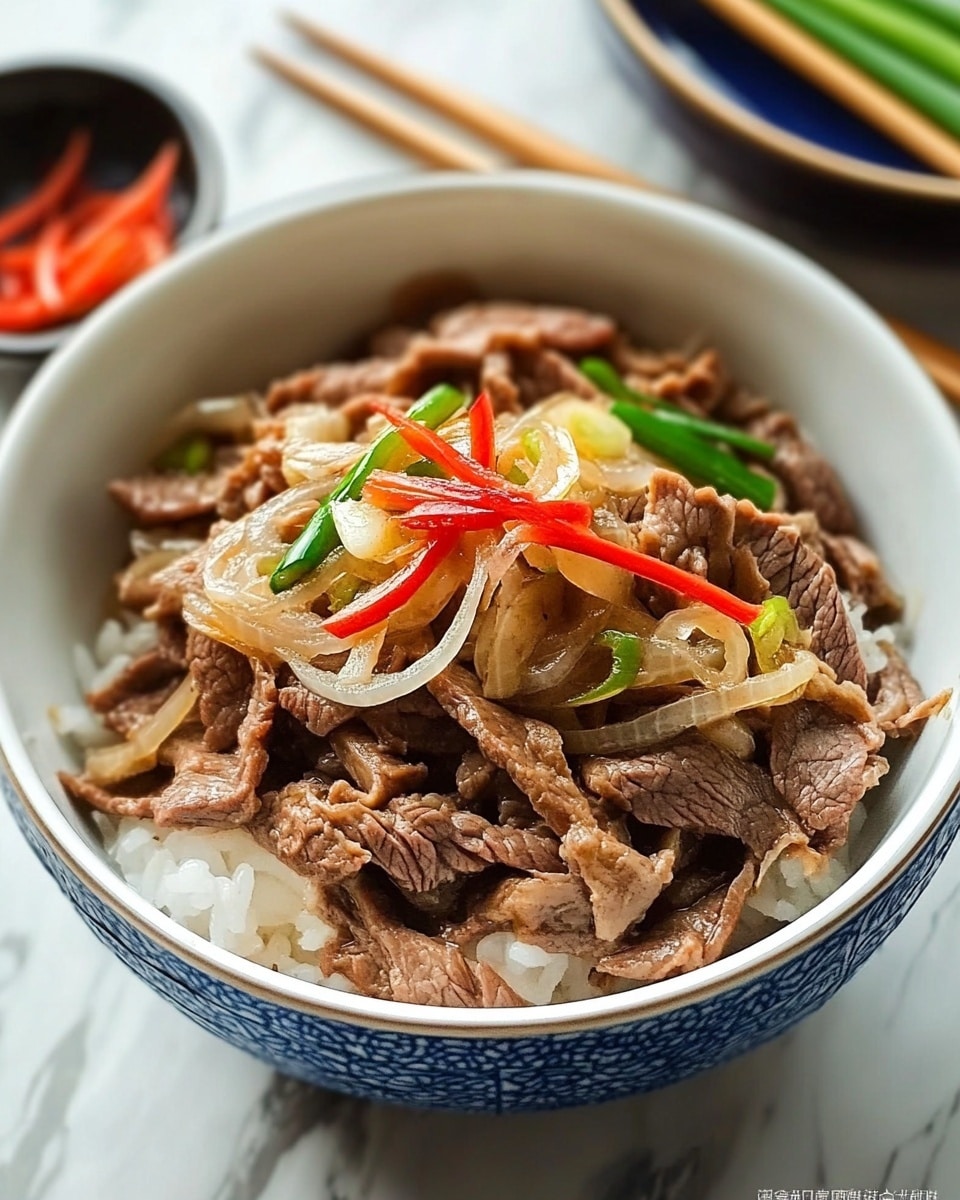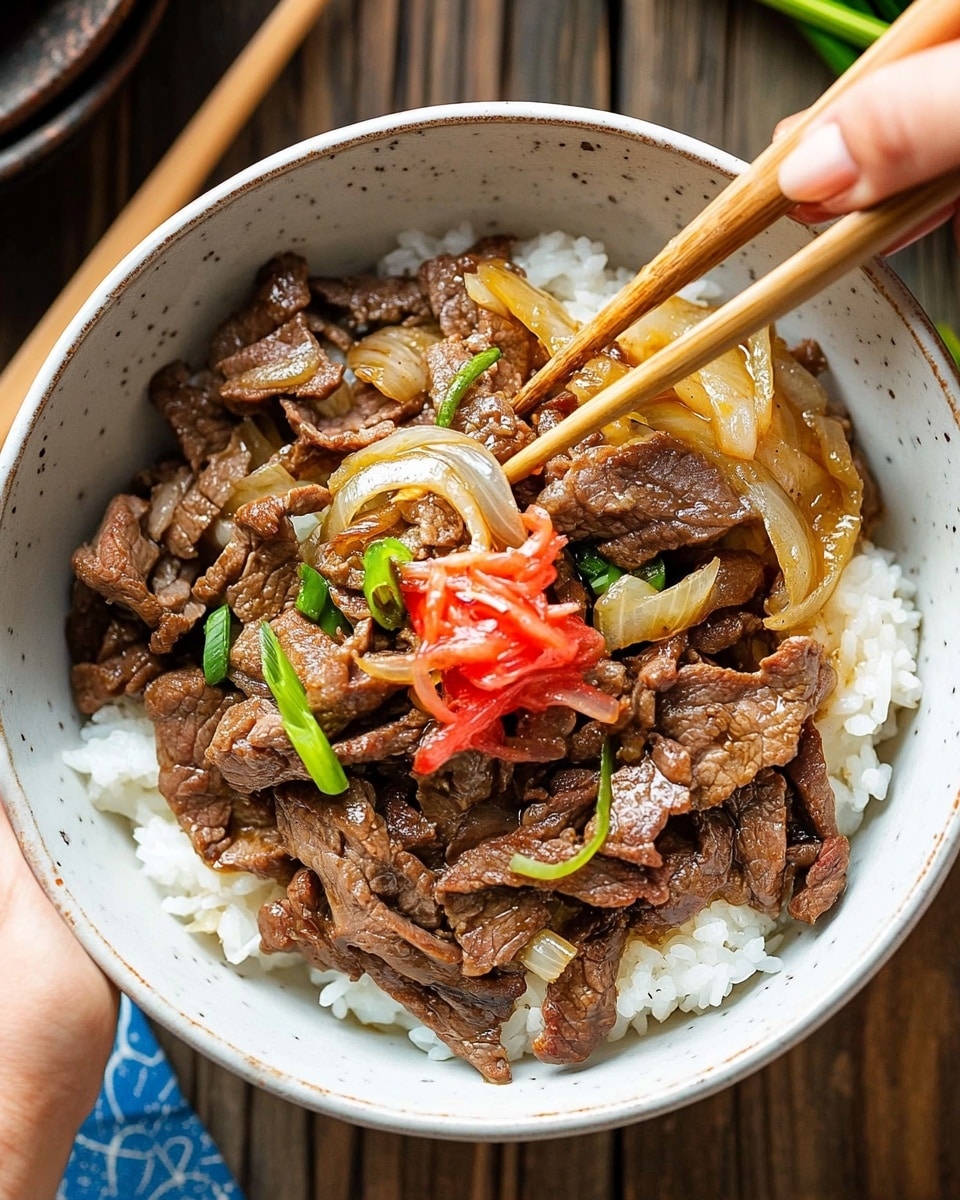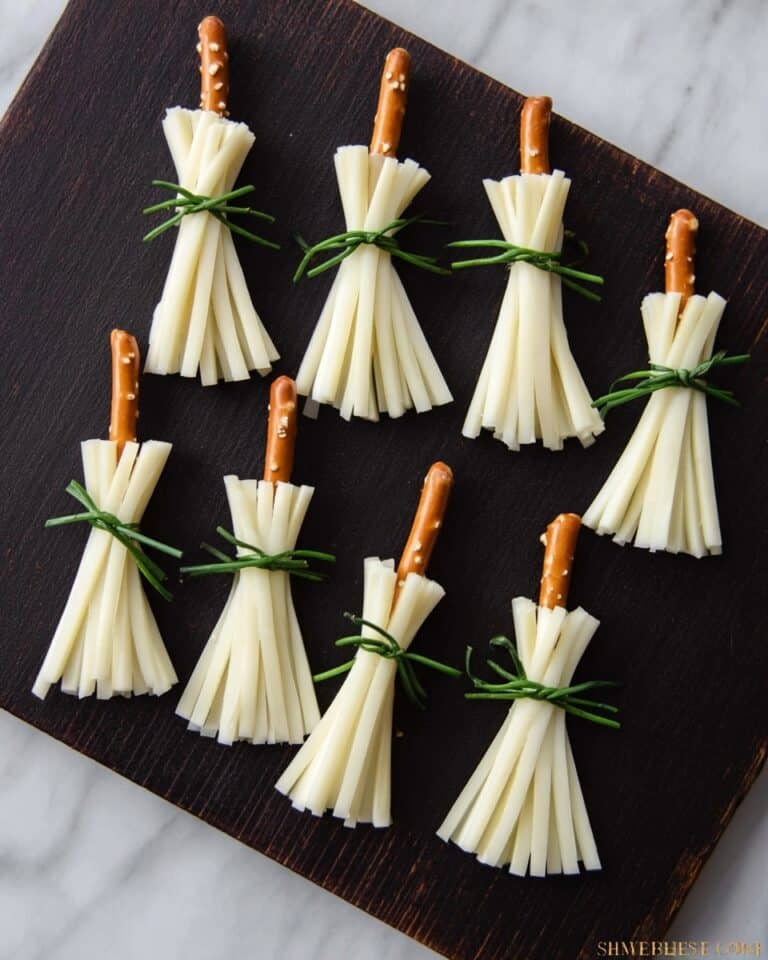I absolutely love this Gyudon (Japanese Beef Rice Bowl) Recipe because it’s the perfect quick and satisfying meal that feels way more special than your typical weeknight dinner. The combination of tender, thinly sliced beef simmered with sweet and savory onions in a rich dashi-based sauce is just pure comfort in a bowl. Whenever I’m craving something hearty yet simple, this recipe never fails to deliver that warm, cozy feeling.
What makes this Gyudon particularly worth trying is how effortlessly it comes together, especially if you prep the thinly sliced beef ahead of time or grab it pre-sliced from the store. You’ll find that balancing the sweetness from the mirin and sugar with the umami of soy sauce and dashi creates a perfect harmony you can’t get from any take-out version. Plus, it’s super easy to customize with toppings and sides to make it exactly the way you like.
Why You’ll Love This Recipe
- Quick & Convenient: You can get this delicious meal on the table in about 20 minutes, which is perfect for busy days.
- Authentic Flavor: The use of dashi and mirin really captures that classic Japanese beef bowl taste everyone raves about.
- Versatile & Customizable: Whether you want to add eggs, extra veggies, or make it vegan-friendly with dashi alternatives, this recipe adapts easily.
- Family Favorite: My kids and guests always ask for seconds, making it a guaranteed crowd-pleaser at any meal.
Ingredients You’ll Need
Choosing the right ingredients really makes a difference in Gyudon (Japanese Beef Rice Bowl) Recipe. I find that using thinly sliced ribeye beef works best because it cooks quickly and stays tender, while simple aromatics like onion and green onion build a great flavor base.
- Onion: Thinly sliced for sweetness and texture; yellow onions are great here.
- Green onion/scallion: Adds a fresh, mild sharpness at the end.
- Thinly sliced beef (ribeye preferred): Semi-frozen beef is easier to slice if you need to cut it yourself.
- Dashi (Japanese soup stock): This is the heart of the broth—use awase dashi or the powdered kind for convenience.
- Sake: Adds depth and subtle sweetness; can swap with dry sherry if needed.
- Mirin: Sweet rice wine that balances the savory notes; substitute with sake and a touch of sugar if needed.
- Soy sauce: Use a good quality one for authentic umami.
- Sugar: Just enough to complement the savory flavors without overpowering.
- Cooked Japanese short-grain rice: Essential for that sticky, fluffy base traditional to donburi dishes.
- Pickled red ginger (beni shoga): Adds zing and acidity to cut through the richness.
Variations
I like to tweak this Gyudon (Japanese Beef Rice Bowl) Recipe depending on what I have on hand or the mood of the day. Don’t hesitate to make it your own—whether that means adding extra veggies, swapping proteins, or changing up the sauces a bit!
- Beef cuts: I’ve tried this with sirloin and even thinly sliced pork belly; each gives the dish a slightly different flavor and richness.
- Vegetarian version: Using vegan dashi and substituting beef with shiitake mushrooms or tofu makes a tasty plant-based alternative.
- Egg addition: My family loves it when I drizzle a beaten egg over the simmering beef— it adds richness and silky texture.
- Spicy twist: Adding a little shichimi togarashi (Japanese seven-spice blend) on top gives it a nice kick if you’re into heat.
How to Make Gyudon (Japanese Beef Rice Bowl) Recipe
Step 1: Prepare Your Ingredients Like a Pro
Start by slicing your onion thinly—this helps it soften quickly and mingle beautifully with the sauce. Then, cut your green onion into thin diagonal slices for a delicate garnish at the end. For the beef, I always pop it in the freezer for about 10 minutes; it firms up and makes slicing easier, giving you clean, tidy strips roughly 3 inches wide. This little trick saves so much frustration, trust me.
Step 2: Build the Flavorful Sauce Base
In a large frying pan (don’t heat it yet!), combine your dashi, sake, mirin, soy sauce, and sugar. Stir well to dissolve that sugar completely — I learned the hard way that undissolved sugar can burn and create an off-taste. Then, layer your sliced onions evenly in the pan, spreading them so each piece has space to cook evenly.
Step 3: Add and Arrange the Beef
Place your beef slices on top of the onions, making sure not to pile them in one spot. You want the beef to be spread out so it cooks uniformly and each bite gets coated in that delicious broth. Remember to separate the slices gently — no clumps!
Step 4: Cook Your Gyudon to Perfection
Cover the pan with a lid and turn on the heat to medium. Once it starts simmering, reduce the heat to low so it gently simmers. Cook for about 3-4 minutes—just enough for the onions to soften and the beef to cook through without drying out. During this time, peek occasionally and skim off any scum or foam that surfaces; clearing this keeps your sauce clear and tasty.
Step 5: Add Final Touches and Serve
Sprinkle the green onions over the top and cover again, cooking for one more minute to brighten flavors. If you want, this is the moment to add beaten eggs, gently pouring them in so they poach in the broth—this makes for a super comforting finish. Divide your freshly cooked Japanese short-grain rice into bowls and spoon the beef and onions on top. Drizzle some of the flavorful broth over the rice, then garnish liberally with pickled red ginger. Trust me, that zing from the ginger is the final touch that makes Gyudon unforgettable!
Pro Tips for Making Gyudon (Japanese Beef Rice Bowl) Recipe
- Freeze the Beef Slightly: Semi-frozen beef slices are much easier to cut evenly and thinly without tearing.
- Skim for Clear Broth: Removing the foam while simmering keeps the sauce clean and enhances the flavor, so don’t skip this step.
- Balance Sweetness to Taste: Everyone’s preference for sweetness varies—start with 1 tablespoon sugar, then adjust next time if you want more or less.
- Don’t Overcook the Beef: Thin slices cook quickly; overcooking can make them tough, so keep an eye during simmering.
How to Serve Gyudon (Japanese Beef Rice Bowl) Recipe
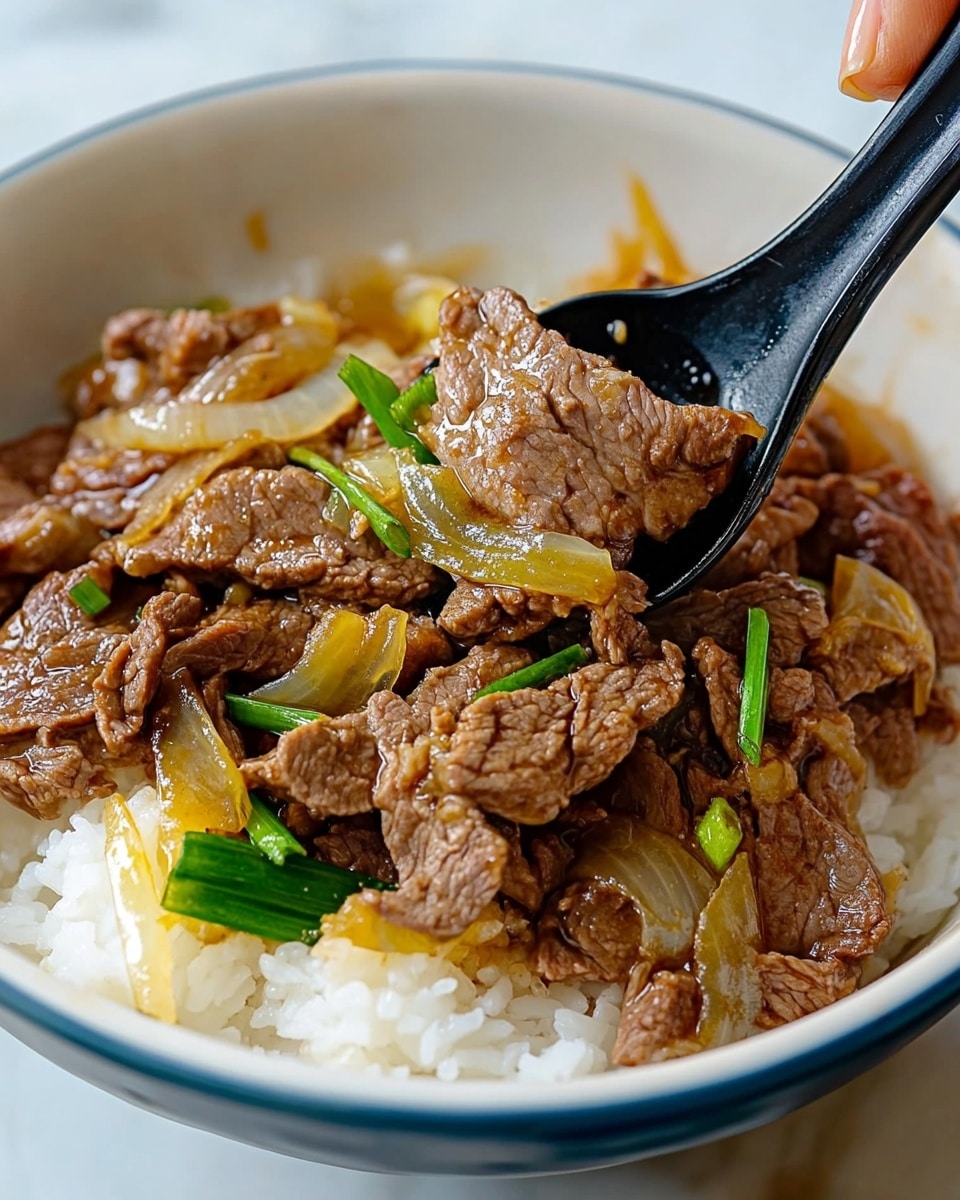
Garnishes
I swear by pickled red ginger (beni shoga) as the ideal garnish—it balances the savory richness of the beef with bright, tangy notes. Sometimes, I add a sprinkle of toasted sesame seeds or thin strips of nori seaweed for extra texture and flavor. If you like a bit of heat, a dash of shichimi togarashi also works wonders.
Side Dishes
Gyudon pairs beautifully with a simple miso soup and some crunchy pickled vegetables like daikon radish or cucumber sunomono. I’ve also served it alongside steamed edamame or lightly dressed spinach ohitashi for a complete Japanese home-cooked meal.
Creative Ways to Present
For special occasions, I like to serve gyudon in donburi-style wooden bowls to enhance the authentic vibe. Sometimes, I create a little DIY topping bar with fresh green onions, sesame seeds, pickled ginger, and raw egg yolks so everyone can customize their own bowl. It’s always a hit and looks fabulous for entertaining!
Make Ahead and Storage
Storing Leftovers
I keep any leftover beef and onions mixture in an airtight container in the fridge and enjoy it within 2-3 days. It really holds up well and sometimes, the flavors even deepen overnight—great for a quick lunch the next day.
Freezing
I’ve frozen Gyudon leftovers a few times in freezer-safe containers. It keeps nicely for up to 3-4 weeks. Just thaw it overnight in the fridge before reheating, and the texture remains surprisingly good.
Reheating
To reheat, I gently warm the beef and onions in a pan over low heat with a splash of water or dashi to loosen the sauce. It prevents drying out and keeps everything tender. I always reheat rice separately or steam it fresh for the best texture.
FAQs
-
Can I use a different cut of beef for this Gyudon recipe?
Absolutely! Thinly sliced ribeye is ideal because it stays tender and cooks quickly, but you can also use sirloin, flank steak, or even chuck if sliced thin enough. Just be careful not to overcook leaner cuts to keep them tender.
-
What can I substitute if I don’t have dashi?
If you can’t find dashi, you can make a quick substitute with vegetable or chicken broth and a splash of soy sauce. For a vegetarian version, kombu (kelp) broth works well as a dashi alternative. While the flavor won’t be exactly the same, it’ll still be delicious!
-
Is this recipe suitable for meal prep?
Yes, this Gyudon recipe is fantastic for meal prep. You can make the beef and onion mixture ahead and store it in the fridge for up to 3 days or freeze for longer. Just reheat gently and serve over freshly cooked rice for best results.
-
Can I add other vegetables to Gyudon?
Definitely! While traditional Gyudon keeps it simple with onions, adding mushrooms, spinach, or shredded carrots can add more texture and nutrition. Just add them early enough during simmering so they cook through.
Final Thoughts
Gyudon (Japanese Beef Rice Bowl) Recipe is one of those dishes I turn to when I want comfort food that’s quick but still feels like a treat. I love how each bite delivers a perfect blend of sweet, salty, and umami flavors, all wrapped up in tender beef and soft onions. If you’re looking to bring a little taste of Japan into your kitchen without fuss, this recipe truly shines—give it a go and I promise you’ll have a new favorite weeknight meal!
Print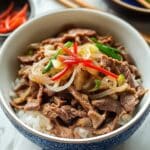
Gyudon (Japanese Beef Rice Bowl) Recipe
- Prep Time: 5 minutes
- Cook Time: 15 minutes
- Total Time: 20 minutes
- Yield: 2 servings
- Category: Rice Bowl
- Method: Stovetop
- Cuisine: Japanese
Description
Gyudon is a classic Japanese beef rice bowl featuring thinly sliced ribeye simmered with onions in a savory-sweet dashi-based sauce, served over fluffy Japanese short-grain rice and garnished with pickled red ginger for a perfect balance of flavor and texture.
Ingredients
Beef and Vegetables
- 1/2 onion (4 oz, 113 g), thinly sliced
- 1 green onion/scallion, thinly sliced diagonally
- 1/2 lb thinly sliced beef (such as ribeye)
Sauce
- 1/2 cup dashi (Japanese soup stock) – use standard Awase Dashi, dashi packet or powder, or Vegan Dashi
- 2 Tbsp sake (or substitute dry sherry, Chinese rice wine, or water for non-alcohol version)
- 2 Tbsp mirin (or use 2 Tbsp sake or water + 2 tsp sugar)
- 3 Tbsp soy sauce
- 1 Tbsp sugar (adjust to taste)
For Serving
- 2 servings cooked Japanese short-grain rice (about 1 2/3 cups or 250 g cooked rice per serving)
- Pickled red ginger (beni shoga or kizami beni shoga), for garnish
Instructions
- Prepare the Ingredients: Thinly slice ½ onion and slice the green onion/scallion diagonally. Partially freeze the beef to make slicing easier, then cut the semi-frozen meat into 3-inch wide pieces.
- Make the Sauce and Arrange in Pan: In a large frying pan (off heat), combine ½ cup dashi, 2 Tbsp sake, 2 Tbsp mirin, 3 Tbsp soy sauce, and 1 Tbsp sugar, stirring to dissolve the sugar. Add the onion slices evenly in the broth, separating the layers.
- Add the Beef: Spread the thinly sliced beef evenly over the onions, separating the slices to cover the pan evenly.
- Cook: Cover the pan with a lid and turn heat to medium. When it starts simmering, reduce heat to low and cook covered for 3–4 minutes. Occasionally open the lid to skim off any scum or fat from the broth using a fine-mesh skimmer.
- Add Green Onions and Finish Cooking: Sprinkle the sliced green onions on top and cook, covered, for another minute. Optionally, beaten eggs can be added at this stage if desired.
- Serve: Divide cooked Japanese short-grain rice into bowls. Drizzle some pan sauce onto the rice, then add the beef and onion mixture. Optionally drizzle more sauce on top and garnish with pickled red ginger. Enjoy immediately.
- Store Leftovers: Store any leftover beef and sauce in an airtight container in the refrigerator for up to 2–3 days or freeze for up to 3–4 weeks.
Notes
- For a Kansai Sukiyaki-style gyudon variation: stir-fry onions in a tablespoon of oil until tender, add beef and sugar, then stir to combine. Add sake, mirin, soy sauce and cook until beef is no longer pink. Optionally drizzle beaten egg over beef and cook covered until set. Top with green onions and serve over rice.
- Partially freezing the beef makes it easier to slice thinly and uniformly.
- Use pickled red ginger to add a refreshing acidic contrast to the rich beef bowl.
- Gyudon sauce uses dashi for umami depth but can be made vegan by using vegan dashi alternatives.
- For a non-alcoholic version, substitute sake and mirin with water plus a bit of sugar.

